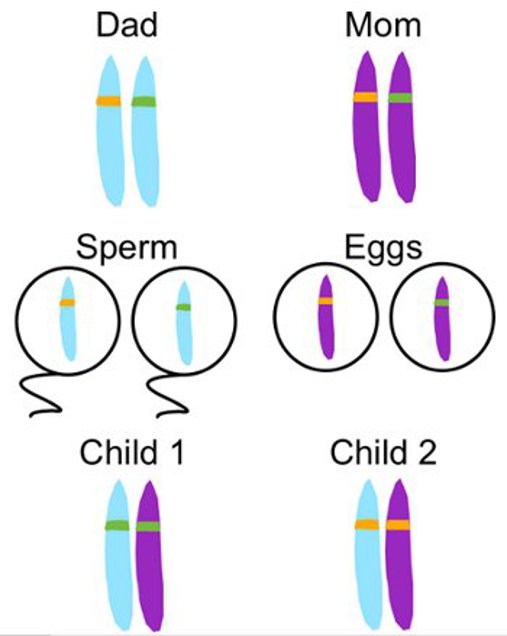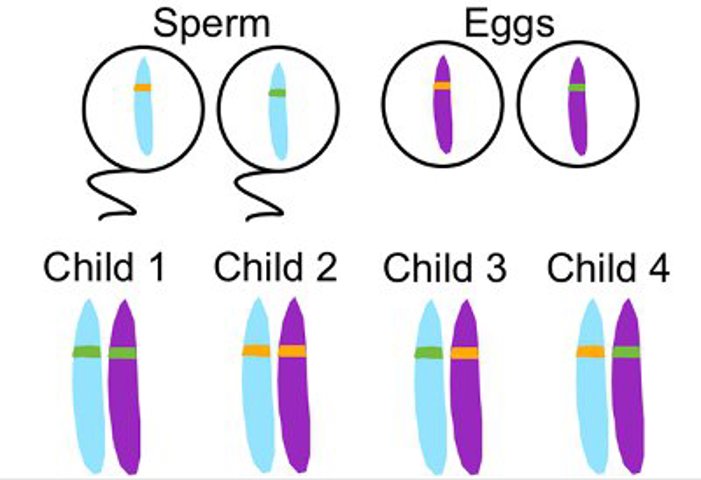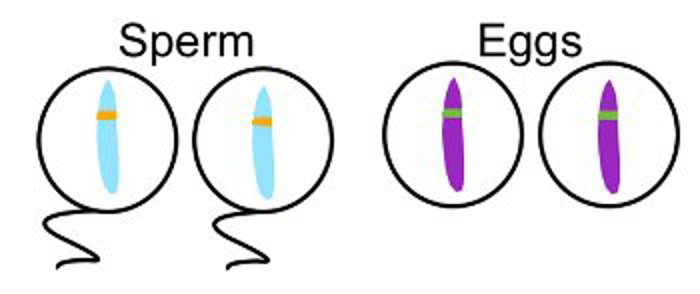
My 2 kids are homozygous for different mutations in the same gene. Do I have one of each?
July 16, 2014

- Related Topics:
- Genetic variation,
- DNA basics
A curious adult asks:
"If I have one child that is homozygous for A1298C and the other child is homozygous for C677T. Are my husband and I both compound heterozygotes for sure? Or, is it possible to be both homozygous for one mutation and either heterozygous or homozygous for the other?"
The bottom line is that you and your husband almost certainly are compound heterozygotes. In other words, you each have one copy of A1298C and one copy of C677T (click here to find out more about A1298C and C677T).
We know this because people pass one copy of each of their genes on to their children. And because A1298C and C677T are both in the same gene, MTHFR.
The child who is homozygous for A1298C has two copies of this version of the MTHFR gene. So he or she must have gotten one copy from you and one from your husband. The same is true for your child with two copies of C677T. That child had to get a C677T version of MTHFR from you and one from your husband.
Looking at the two together, we see that each of you passed on a C677T and an A1298C. Since we almost always have two copies of each of our genes, that means you and your husband have one of each. You are each compound heterozygotes for A1298C and C677T.
Other possibilities simply don’t work. For example, it can’t be that one of you has two copies of the A1298C version and the other has two copies of the C677T version. If this were the situation, then all of your kids would be compound heterozygotes. In other words, one of you would always pass a C677T and the other would always pass an A1298C.
So there you have it. We can tell from the fact that one of your kids has two copies of A1298C and the other has two copies of C677T that you and your husband have one of each.
Now I want to go into more detail on what is actually going on when you pass your DNA down to your kids. In the end, I think you’ll see why you and your husband must each have a copy of C677T and a copy of A1298C.
Genes Come in Pairs
As I said, people have two copies of most of their genes. One copy comes from each parent.
The gene we are talking about here is the MTHFR gene. Most everyone has two copies of this gene too.
As humans we all basically share the same set of genes. What makes us each unique is that genes can come in different versions. Someone with blue eyes has the blue eye version of an eye color gene and someone with brown eyes has the brown eye version of the same gene.
MTHFR also comes in different versions. There is the “wild type” version, which the majority of people have. Then there are the C677T and the A1298C versions that we are talking about here.
Our genes are stored on long pieces of DNA called chromosomes. Most people have 23 pairs of chromosomes with one of each pair coming from mom and one from dad.
Eggs and sperm have only one of each pair of chromosomes. So an egg has 23 chromosomes and so does a sperm. When they combine, they make an embryo with 23 pairs of chromosomes.
Okay, so now we are ready to dig deeper into your situation. What I am going to do is show you how things could shake out if you and your husband are compound heterozygotes.
How you Got Two Homozygous Children
If you take a look at the diagram below, you will see that mom and dad each have two pairs of chromosome 1. The orange line on the chromosome represents the C677T and the green represents A1298C.

As you can see, mom and dad each have one chromosome with C677T and one with A1298C. When they make eggs and sperm, they will have only one copy of chromosome 1. So every egg or sperm will have either C677T or A1298C.
You can see that a sperm with the green version could come together with an egg that also has the green version. This would make an A1298C homozygous child (child #1). Child #2 would come from the joining of sperm and eggs that have the orange, C677T version.
Of course, it is also possible that you could have a child that is a compound heterozygote like you and your husband. In that case, one of you would pass a chromosome with C677T and the other would pass one with A1298C like this:

As you can see, an egg with the green A1298C could come together with a sperm that has an orange C677T. This would make a compound heterozygous child.
There is another way you could get a compound heterozygous child. An orange C677T egg could come together with a green A1298C sperm.
So, there are two different ways that the eggs and sperm could come together to make a compound heterozygote. But there is only one way to get an A1298C homozygous child, and only one way to get a C677T homozygous child.
This means there is a 2 in 4 (50%) chance that your children will be compound heterozygotes. But there is only a 1 in 4 (25%) chance that your children will be an A1298C homozygote or a C677T homozygote. So, there is a 50% chance that your next child will be compound heterozygous just like you.
Homozygous Parents
To wrap things up, let’s imagine a parent that is homozygous for A1298C and one that is homozygous for C677T. Here is what their egg and sperm would look like:

As you can see, the dad can only make C677T sperm and the mom A1298C eggs. This means every child will be a compound heterozygote. They will have one of each version
By now it should be clear why you and your husband must be compound heterozygous for C677T and A1298C. It is simply not possible that either of you is homozygous for one of these versions.
The examples described here are not unique to MTHFR. The same principles apply to almost all your genes. For example, if you and your husband are both heterozygous for other genes, then there is a 50% chance that your children will also be heterozygous.

Author: Cathrine Hartzell
When this answer was published in 2014, Catherine was a Ph.D. candidate in the Department of Immunology, studying calcium signaling and T-cell activation in Richard Lewis’ laboratory. Catherine wrote this answer while participating in the Stanford at The Tech program.
 Skip Navigation
Skip Navigation
